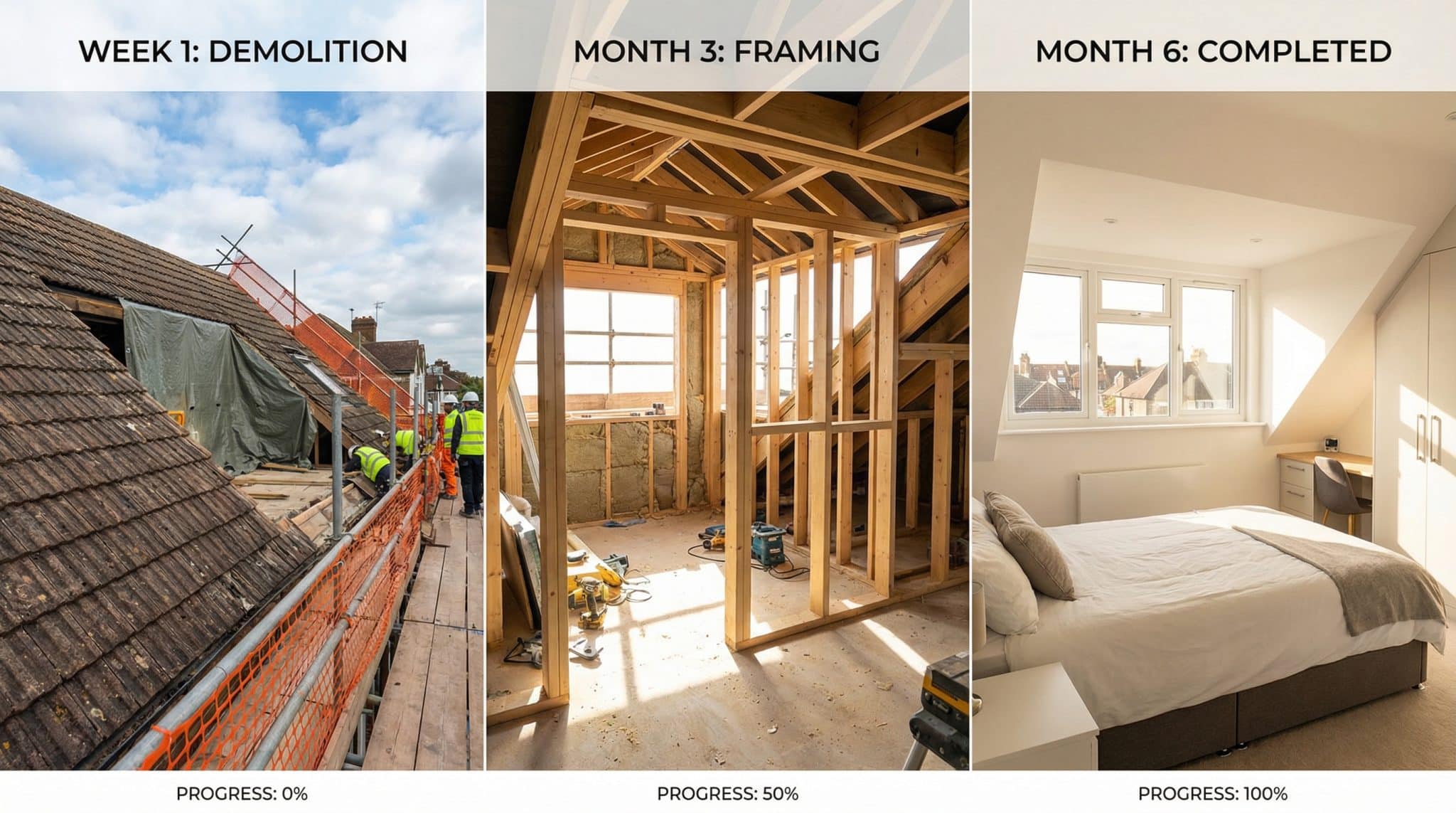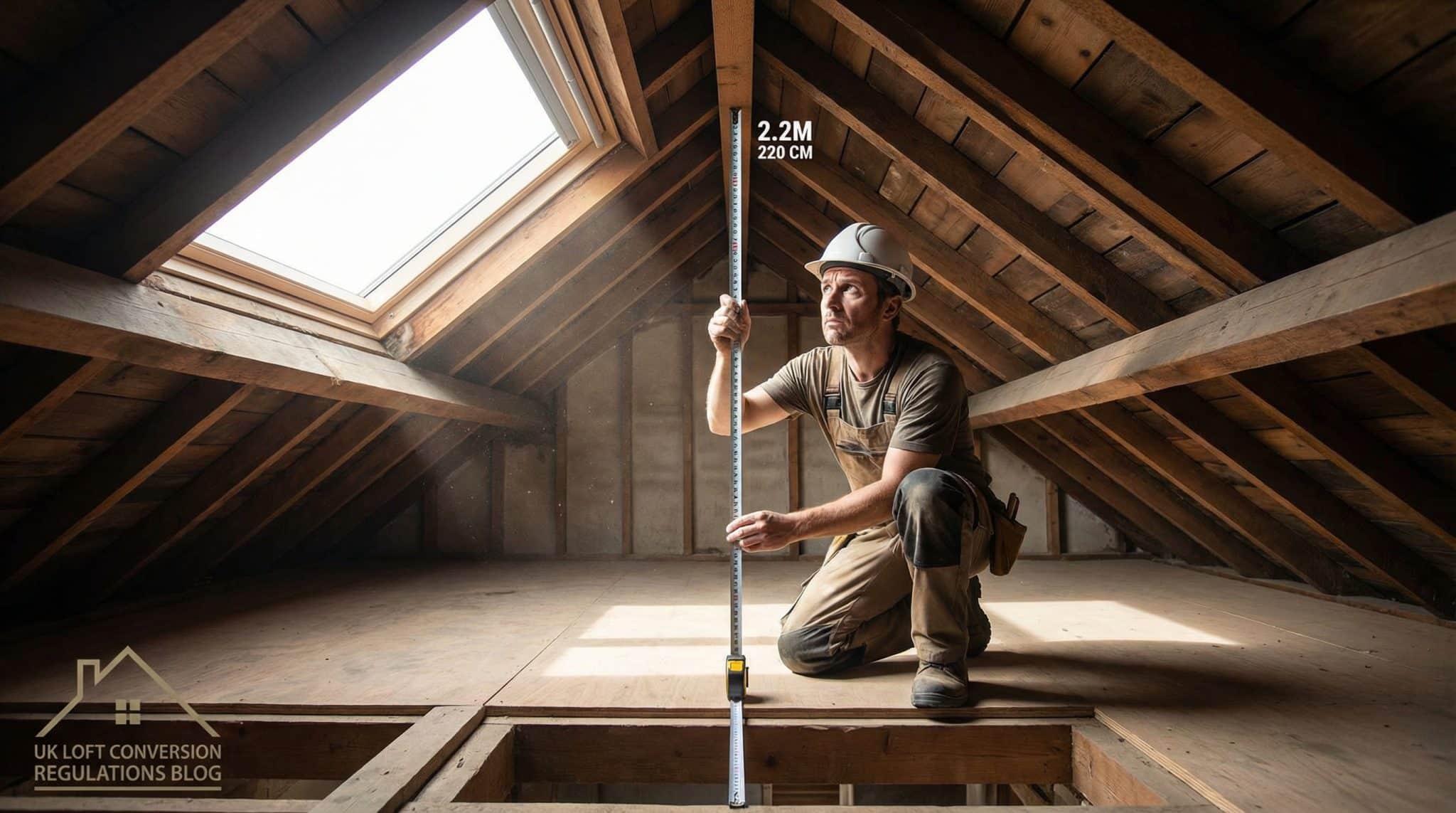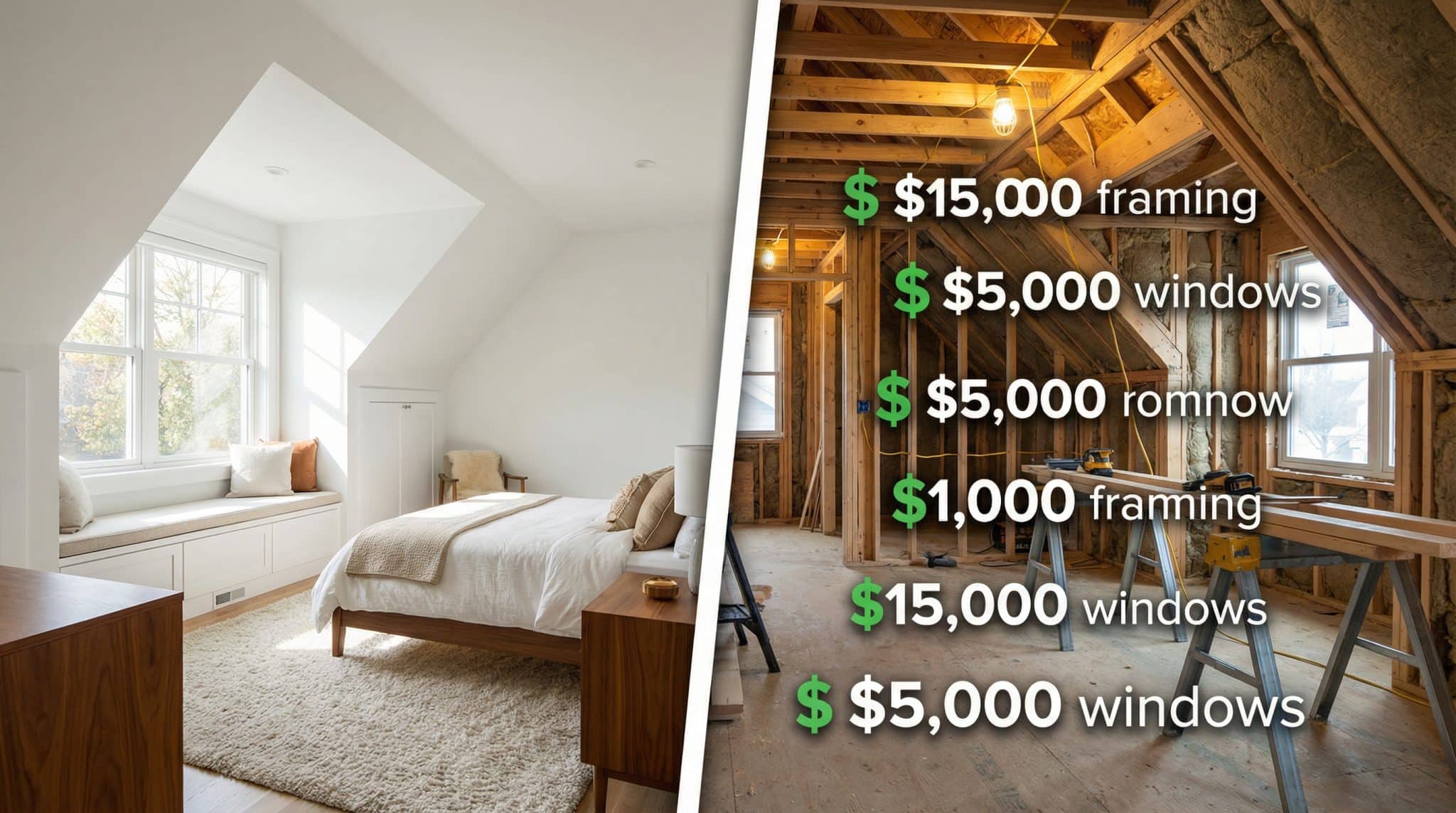Planning to build a fence but worried about breaking UK height rules?
I’ve seen too many homeowners face costly enforcement notices because they didn’t know the simple height limits that could have saved them thousands.
What if I told you that most fence projects can be done legally without any planning permission – you just need to know the basic rules that councils use?
In the next few minutes, I’ll walk you through exactly what heights are allowed in your back garden versus front garden, when you need permission, and how to avoid the legal headaches that catch so many property owners off guard.
Let me show you the straightforward rules that will keep your fencing project legal and stress-free.
How High Can a Fence Legally Be in the UK?
Back and side gardens allow fences up to 2 metres tall without planning permission, while front gardens near roads must stay under 1 metre high for safety reasons.
These standard limits apply to most residential properties across England and help maintain clear sightlines for drivers and pedestrians.
Key Fence Height Guidelines:
- Listed buildings – Face stricter rules regardless of fence height.
- Conservation areas – May require permission for any boundary changes.
- Material restrictions – Solid brick walls might need approval even when short.
- Special properties – May require approval for any boundary modifications.
- Local council variations – Can add extra rules based on the area’s character.
- Planning policy factors – Additional restrictions depend on location specifics.
- Safety considerations – Height limits protect driver and pedestrian visibility.
Most homeowners can build standard height fences without permission, but listed buildings, conservation areas, and special properties face additional restrictions.
Always check with your local council first if your property has special designations or you’re using unusual materials like solid walls.
Legal Fence Height Limits by Property Type
This table shows the maximum fence heights allowed across different property locations in the UK.
It covers planning permission requirements and special considerations for various property types. Use this quick reference guide to check if your fence project needs council approval.
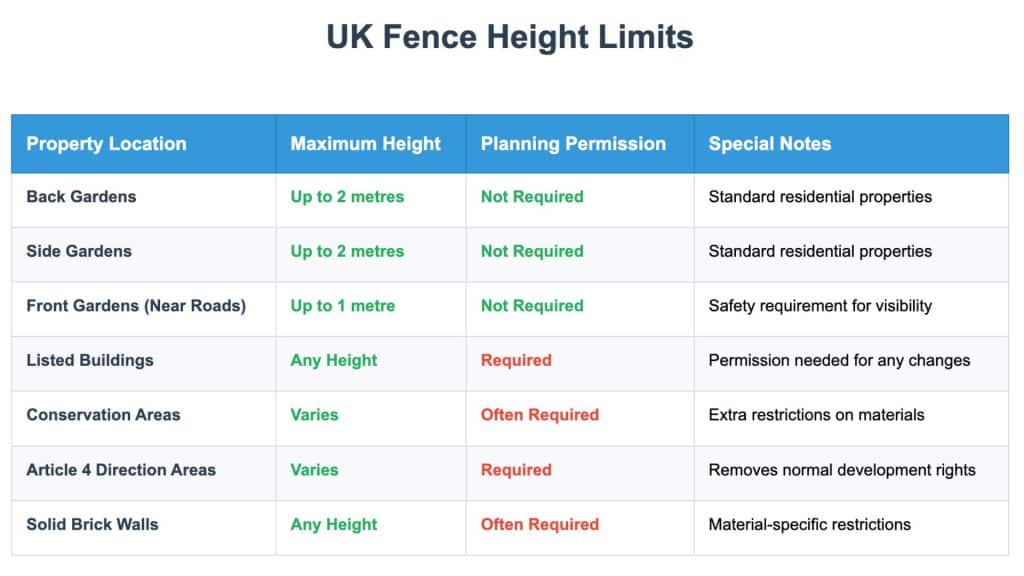
The information in this table applies to most residential properties in England. Always check with your local planning authority before starting any fence construction project.
Different councils may have additional restrictions based on local policies and area characteristics.
When Is Planning Permission Required for a Fence?
Most fences can be built without permission, but certain situations require formal approval. Understanding these exceptions helps homeowners avoid legal problems and costly mistakes.
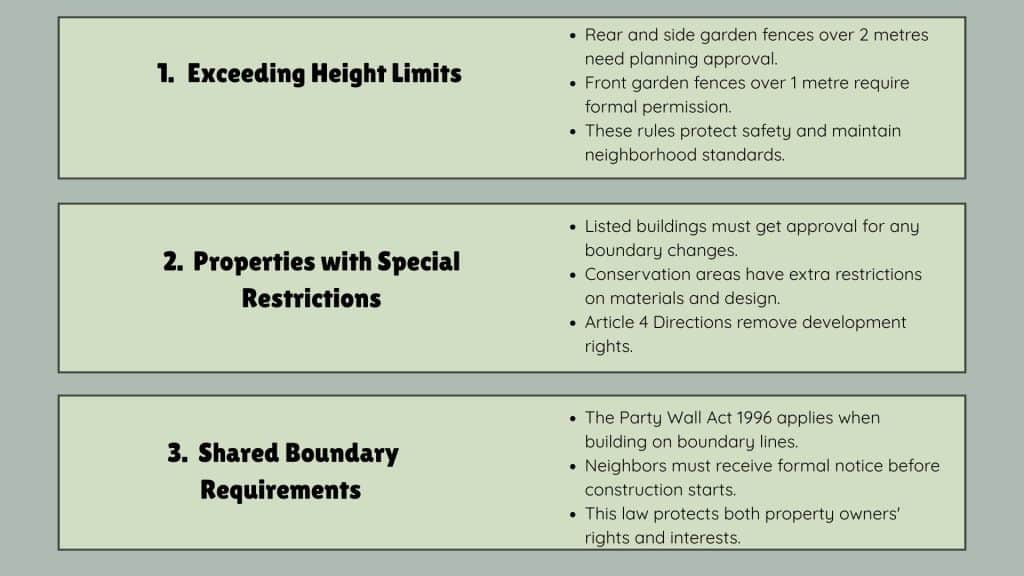
Most fences don’t need planning permission, but the exceptions can be costly if you get them wrong. Check the rules before building to avoid having to tear down your fence and pay fines later.
How to Apply for Planning Permission for a Fence?
Getting planning permission for fences requires careful preparation and following the right steps. A well-prepared application increases approval chances and avoids costly delays.
Step 1: Check Local Council Rules
Start by reviewing council planning policies for fences. Each area has different requirements for materials and heights. Contact the planning department for specific guidance on local restrictions.
Step 2: Prepare Required Documents
Gather all necessary paperwork before applying. Site plans must show fence location and boundary lines. Elevation drawings should display fence height and design details.
Step 3: Submit Application and Wait
Complete the planning application form with accurate information. Pay the required fees through the council’s online portal. Decision times typically range from 8 to 12 weeks.
Tips for Successful Applications
Follow these expert strategies to increase your chances of getting planning permission approved quickly and avoid common application mistakes that lead to costly delays.
Proper preparation and attention to detail can mean the difference between approval and rejection.
1. Talk to Neighbors Early: Discuss fence plans with adjacent property owners before applying. Address any concerns they raise about privacy or access. Written neighbor support strengthens the application significantly.
2. Follow Local Design Standards: Choose materials that match the area’s character and style. Consider how the fence affects street views and property appearance. Councils favor designs that fit existing neighborhood patterns.
3. Provide Detailed Plans: Submit clear, accurate drawings showing exact measurements and materials. Include photos of the existing boundary and the surrounding area. Professional drawings improve approval chances.
4. Submit Complete Applications: Include all required forms, fees, and documents from the start. Missing paperwork causes delays and rejection. Double-check council requirements before submitting.
5. Explain Your Reasons: Write a brief statement explaining why you need the fence. Valid reasons include security, privacy, or replacing damaged boundaries. Clear justification helps planning officers understand your needs.
Consequences of Building Without Permission
Building fences that exceed legal height limits can lead to serious problems with local authorities. Understanding these consequences helps homeowners make informed decisions about fence construction.
1. Council Enforcement Action
Local councils can issue enforcement notices for illegal fence heights. These notices require immediate action to fix the problem.
Property owners must reduce fence height or remove sections completely. Ignoring these notices can lead to more significant legal issues.
2. Financial Penalties
Councils can impose fines for non-compliance with enforcement orders. These penalties increase if homeowners refuse to cooperate.
Court costs may add to the total expense. Legal fees can become very expensive quickly.
3. Neighbor Disputes
Oversized fences often cause complaints from adjacent property owners. Issues include blocked light, reduced privacy, and spoiled views.
These disputes can damage relationships permanently. Some cases end up in costly legal battles.
4. Right to Appeal
Property owners can challenge enforcement notices through official appeals. Appeals must be submitted within strict time limits.
Missing deadlines means losing the right to contest the decision. Legal advice helps during the appeal process.
Alternatives to Traditional Fencing

Property owners have several options beyond standard fences for creating boundaries and privacy. These alternatives often follow different rules and may offer more flexibility than solid fencing structures.
1. Natural Plant Barriers: Hedges and shrubs create living boundaries that grow over time. Most hedge types don’t need planning permission regardless of height. Popular choices include privet, laurel, and leylandii for fast-growing screens. These options provide year-round privacy while supporting local wildlife.
2. Decorative Screens and Trellises: Wooden or metal trellises offer partial privacy with visual appeal. These structures often fall under different planning rules than solid fences. Climbing plants can be added to increase coverage and create green walls. Screen panels come in various designs to match property styles.
3. Mixed Boundary Solutions: Combining fencing with plants creates attractive and practical boundaries. Low fences with hedge planting above can stay within height limits. This approach offers immediate privacy from fencing, plus long-term benefits from plants. Mixed solutions often prove more cost-effective than tall solid fences.
Final Thoughts
Apprehending UK fence height rules protects you from costly enforcement notices and neighbor disputes.
Remember, 2 metres for back gardens, 1 metre for front boundaries; these simple limits keep most projects legal. Special properties like listed buildings need extra care, but the basic rules work for most homeowners.
Before you start building, always check with your local council about any area-specific restrictions. A quick phone call can save you thousands in removal costs later.
Don’t let planning confusion stop you from creating the privacy you want. Now you have the knowledge to do it right.
Ready to build your fence? Start by measuring your boundaries and confirming which rules apply to your property type.
Learn more about maintaining and improving your property.
Frequently Asked Questions
Does Trellis Count as Fence Height in The UK?
Yes, trellis counts toward total fence height. A 1.8m fence with 0.3m trellis equals 2.1m total height, which exceeds the 2m limit and needs planning permission.
What Is the Tallest Residential Fence I Can Put Up?
2 metres in back and side gardens without planning permission. Front gardens near roads are limited to 1 metre. Taller fences need council approval.
How High CanA Hedge Be in the Front Garden in The UK?
No height limit for hedges in front gardens. Unlike fences, hedges don’t need planning permission regardless of height, but neighbor disputes may apply.




